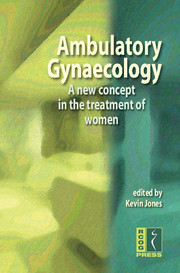Book contents
- Frontmatter
- Contents
- ABOUT THE AUTHORS
- ABBREVIATIONS
- PREFACE
- Chapter 1 Introduction
- Chapter 2 Anaesthesia and analgesia for outpatient gynaecology
- Chapter 3 Colposcopy services
- Chapter 4 Abnormal uterine bleeding
- Chapter 5 Endometrial ablation
- Chapter 6 Urogynaecology: urinary incontinence and genital prolapse
- Chapter 7 Infertility
- Chapter 8 Early pregnancy units and emergency gynaecological services
- Chapter 9 Pelvic utrasound and interventional radiology
- Index
Chapter 8 - Early pregnancy units and emergency gynaecological services
Published online by Cambridge University Press: 05 June 2014
- Frontmatter
- Contents
- ABOUT THE AUTHORS
- ABBREVIATIONS
- PREFACE
- Chapter 1 Introduction
- Chapter 2 Anaesthesia and analgesia for outpatient gynaecology
- Chapter 3 Colposcopy services
- Chapter 4 Abnormal uterine bleeding
- Chapter 5 Endometrial ablation
- Chapter 6 Urogynaecology: urinary incontinence and genital prolapse
- Chapter 7 Infertility
- Chapter 8 Early pregnancy units and emergency gynaecological services
- Chapter 9 Pelvic utrasound and interventional radiology
- Index
Summary
Introduction
The early 1990s saw the inception of the first early pregnancy units (EPUs), which were established to treat women with complications of pregnancy in the first trimester. It was recognised that EPUs were an efficient way of organising the services compared with traditional care pathways. Demand on the service has increased in recent years with the use of home pregnancy kits and the consequent confirmation of pregnancies at extremely early gestations. In recent years, many units have developed into comprehensive early pregnancy care facilities, incorporating day care for women undergoing surgical or medical interventions. Prompt diagnosis and treatment in a dedicated EPU facility ensures that the woman receives continuity of care, which is frequently led and delivered by nursing staff. Anxiety is minimised and ongoing health is ensured through support and monitoring.
More recently, this concept has been expanded to incorporate all emergency gynaecological care that previously presented to an accident and emergency unit. Women with acute gynaecology problems should ideally be seen in emergency gynaecology units (EGUs), which are set up and run along similar lines as the EPU.
National targets
The National Service Framework for Children, Young People and Maternity Services is clear in its aim of providing patient-centred care with the identification and appropriate management of relevant social, medical and psychiatric problems. This framework follows a one-stop assessment, diagnosis and management ethos as set out in the NHS Plan.
- Type
- Chapter
- Information
- Ambulatory GynaecologyA New Concept in the Treatment of Women, pp. 95 - 105Publisher: Cambridge University PressPrint publication year: 2008



